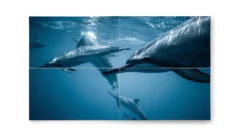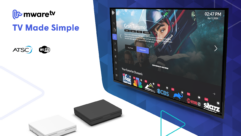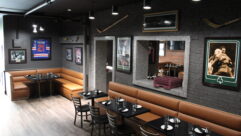
TV One C2-7260
Oct 1, 2007 12:00 PM,
By Jeff Sauer
Multi-function video processor boasts flexible system architecture.

Over the last decade and a half, TV One has become known for breaking down barriers, both in terms of aggressive pricing for video-processing components and for a propensity to build products that tend to overwhelm traditional product categories. That’s true again with the new HD/SD SDI-capable C2-7260.
Like many products in TV One’s Corio (now Corio2) family, the C2-7260 is a multipurpose, multi-function video-processing engine. It’s a 2-channel, high-definition presentation switcher with two frame synchronizers that allow for seamless switching between multiple sources. It’s also a high-definition video scaler for both motion video and data inputs. And it’s a worldwide standards converter. It’s a chroma keyer, it’s a time base corrector, heck, it’s even an edge-blending engine.
Overall, the C2-7260 is really TV One taking advantage of a unique system architecture that leverages a field-programmable gate array (FPGA) instead of using a chipset with a specific set of functions. More often, manufacturers start with third-party chipsets and then build accompanying circuitry and firmware to allow those chipsets to perform specifically desired tasks. It’s a practical route because the base components support market-specific, yet fairly generic, functions that can appeal to a wide range of potential hardware makers. Such chipsets are therefore typically affordable.
TV One’s Corio chip is more like the CPU in a computer. Although it is designed to excel at specific video-related number crunching, the firmware is not fixed in the silicon, as would be the case for typical chips. There are higher up-front costs involved in developing such a powerful engine if you’re building, say, just a scaler, but TV One has spread those costs across a broad product line. It’s also provided company code writers with a consistent platform that doesn’t require re-inventing the proverbial wheel each time the company adds a new product or feature. And that, in turn, has allowed TV One to maintain aggressive prices across the board.
TV One’s higher-end products, including the C2-7260, ultimately receive the feature sets of many other products in the Corio2 family. And because the firmware always resides on an FPGA, it’s always updateable and upgradeable. For example, TV One literally added edge-blending capabilities to already purchased, previous-generation products via a firmware update. It’s a benefit to the architecture that potentially increases the longevity of the hardware.
MORE INS AND OUTS
With the C2-7260, TV One is addressing the transition from analog to digital sources. It features eight HD/SD SDI inputs and two HD/SD SDI outputs, as well as three DVI-I inputs and two out. Each of those 11 inputs can, via a conversion cable, support traditional analog inputs (YPbPr component or analog RGB) if necessary, although the unit also includes three S-Video and three composite video inputs and two each out for supporting legacy equipment. RS-232 and Ethernet ports on the back panel provide for external control.
Not surprisingly, given the broad functionality and inputs, the front panel is awash in buttons. As you’d expect from a typical presentation system, there are two rows of input buttons to allow for previewing and then “taking” each individual input. Rather than having a dedicated button for each of the inputs in each row, a Shift button is available to allow TV One to combine two inputs. There are also dedicated buttons for functions such as picture-in-picture, key, zoom, fade, cut, etc., as well as four macro buttons (seven with the Shift key, the eighth is a macro reset).
The remarkable thing about the C2-7260 is that it is literally several products. It is billed as a dual-channel HD video processor, but that can, and does, mean different things. There are three operating modes that allow you to use the C2-7260 in very different ways. Switcher mode is straightforward: a 2-channel presentation switcher that features fades, wipes, and pushes. Independent mode is a little more unique, although the name says it all. You can literally use one C2-7260 as two separate video processors, with two different simultaneous outputs. Dual-PIP mode puts two sources’ inputs into two windows simultaneously on a single output.
To operate all of those unit-front buttons, and to access many of the features, the C2-7260 has a small black-and-white LCD and an awkwardly diminutive navigation knob. The menus are hierarchical and functional, but you sure wouldn’t want to try live switching anything complicated or from inside a dimly lit control room. A much better solution would be to add TV One’s CC-300 control console, which can be configured to control the C2-7260.
Admittedly, the CC-300 is a controller designed for TV One’s broader product line and not the C2-7260 specifically, and it actually has only 11 input buttons on each of two busses instead of the 17 on the C2-7260. (I’d expect TV One to address this with a revised console in the coming months.) And, if you use the CC-300 with the C2-7260, you’ll even need to physically relabel the buttons to match the proper inputs. However, aside from that minor awkwardness, the CC-300 is fully programmable to match buttons with functions you use. More importantly, it features a T-bar for manual transition and a large joystick for navigating through the menus, as well as a near-6in. LCD screen that displays a lot more than the C2-7260’s LCD. Alternatively, TV One also offers a software interface for controlling the C2-7260 from a Windows computer.
TV One’s quality is extremely good. The C2-7260 does a very good job taking and scaling the large variety of signals I tested using an HD SDI-capable test pattern generator, going out both SDI and via DVI. Similarly, going in the other direction with input text and graphics for a data source, I was able to read very small eight- and even six-point fonts with output to a video monitor.
At a list price of $13,500, it’s a nice value for an HD-SDI dual-channel switcher. But then, as TV One likes to point out, you get a lot of added features for free, such as the two video processors in one, edge blending, and more. While all those features do tend to leave the C2-7260 with something of a steeper learning curve, particularly if you try and sort it out using the tiny LCD screen, that penchant for loading products with features makes theC2-7260 a tweaker’s delight, if not a video Swiss Army knife.
PRODUCT SUMMARY
Company: TV One
www.tvone.com
Product: C2-7260
Pros: Eight HD/SD-SDI inputs, high-quality seamless video switching, numerous additional features.
Cons: Menus are difficult to navigate without either an external control console or computer interface.
Price: $13,500 MSRP
SPECIFICATIONS
Inputs: 8x HD/SD SDI, 3x DVI-I, 3x S-Video, 3x BNC composite
Outputs: 2x HD/SD SDI, 2x DVI-I,
2x S-Video, 2x BNC composite
Genlock: All video inputs
Video decoder: 9-bit
Sampling: 24-bit
Internal processing: RGB 4:4:4
Analog resolution: Up to 2048×2048
DVI resolution: DVI up to 1280×1024
HD resolution: HD resolutions up to 1080p
Image adjust: Size, position, brightness, contrast, saturation, hue, video levels for RGB
Scaling: 10% to 1,000%
Features: Dual PIP
Warranty: 2-year parts and labor










